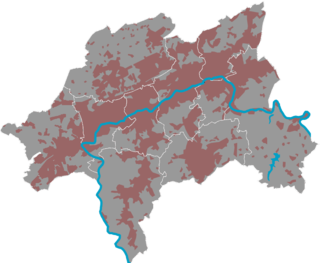Hard caves
| Hardthöhlen Obere Hardthöhle , Untere Hardthöhle and Unterste Hardthöhle
|
||
|---|---|---|
| Location: | Wuppertal , Hardtberg | |
| Height : | 156 m | |
|
Geographic location: |
51 ° 15 '44 " N , 7 ° 10' 8" E | |
|
|
||
| Overall length: | 4037 meters | |
| Level difference: | 62 meters | |
The Hardthöhlen are a large cave system in the Wuppertal city area. The caves under the Hardt-Anlagen , a park on the Hardtberg in the city area, are not open to the public.
Position and extent
The cave system was originally known as the Upper Hardthöhle ( cadastral number 4709/003) and the Lower Hardthöhle (4709/004). For a long time it was assumed that the two caves are not connected. However, the working group Kluterthöhle e. V. (AKKH) discovered a strong danger of collapsing connection between the two caves, which was expanded today so that Befahrung the connection gefahrarm possible. Technically, it is therefore only a single cave.
In the meantime the lowest Hardthöhle has been discovered, which is a continuation of the Hardthöhle down to the groundwater.
The labyrinth-like cave system has been explored over a length of 4037 meters and a depth of 62 meters. The Hardthöhlen are the second longest in the Westsauerland and Bergisches Land area and rank 20th among the caves in Germany.
geology
The cavities are located in limestone , the locally into the otherwise from graywackes and shales dominated Upper Honselmann layers (Givet stage, means Devon is turned on). In these Biostrom -Kalken of the two lower Hardt caves include fossils of a nautiloid been found.
history
During the Second World War , a small part was used to build an air raid shelter. When children got lost in the cave system in the 1960s, the entrance was closed.
natural reserve
The Hardthöhlen was first placed under protection with the Reich Nature Conservation Act of 1937/38. This was confirmed by the state of North Rhine-Westphalia on June 23, 1966 with the classification as a nature reserve "because of the species-rich cave fauna". The Kluterthöhle working group was commissioned by the city of Wuppertal to look after the cave.
See also
literature
- Detlef Wegener, Ulrich Brämer: Unter der Hardt: 150 years of cave research in the Wuppertal Hardtberg. Working group Kluterthöhle eV, Ennepetal, 2019, ISBN 978-3-00-063220-4 .
Web links
- "Hardthöhlen" nature reserve (W-001) in the specialist information system of the State Office for Nature, Environment and Consumer Protection in North Rhine-Westphalia
- Working group Kluterthöhle eV
Individual evidence
- ↑ M. Schnadwinkel: Overview of the Westsauerland / Bergisches Land cadastre. (pdf; 76 kB) In: akkh.de. March 3, 2003, archived from the original on June 30, 2007 ; accessed on June 20, 2020 .
- ↑ Thilo Müller, Andreas Wolf: List of the longest and deepest caves in Germany. In: arge-grabenstetten.de. January 2020, accessed June 20, 2020 .
- ↑ Stefan Voigt: Karst hydrology and karst caves of the Wuppertaler Kalkmulden. 20th Symposium River Basin Management / Wupper Area Forum, July 11, 2017 ( PDF of the presentation for the lecture 11 MB)
- ↑ Lutz Koch, Stefan Voigt, Carsten Brauckmann: Nautilids from the Kluterthöhle (Ennepetal, North Rhine-Westphalia), from neighboring caves and other sites in the Upper Honsel layers (Lower Givetium). Geology and paleontology in Westphalia. Vol. 90, 2018, pp. 15–24 ( PDF 16.5 MB)
